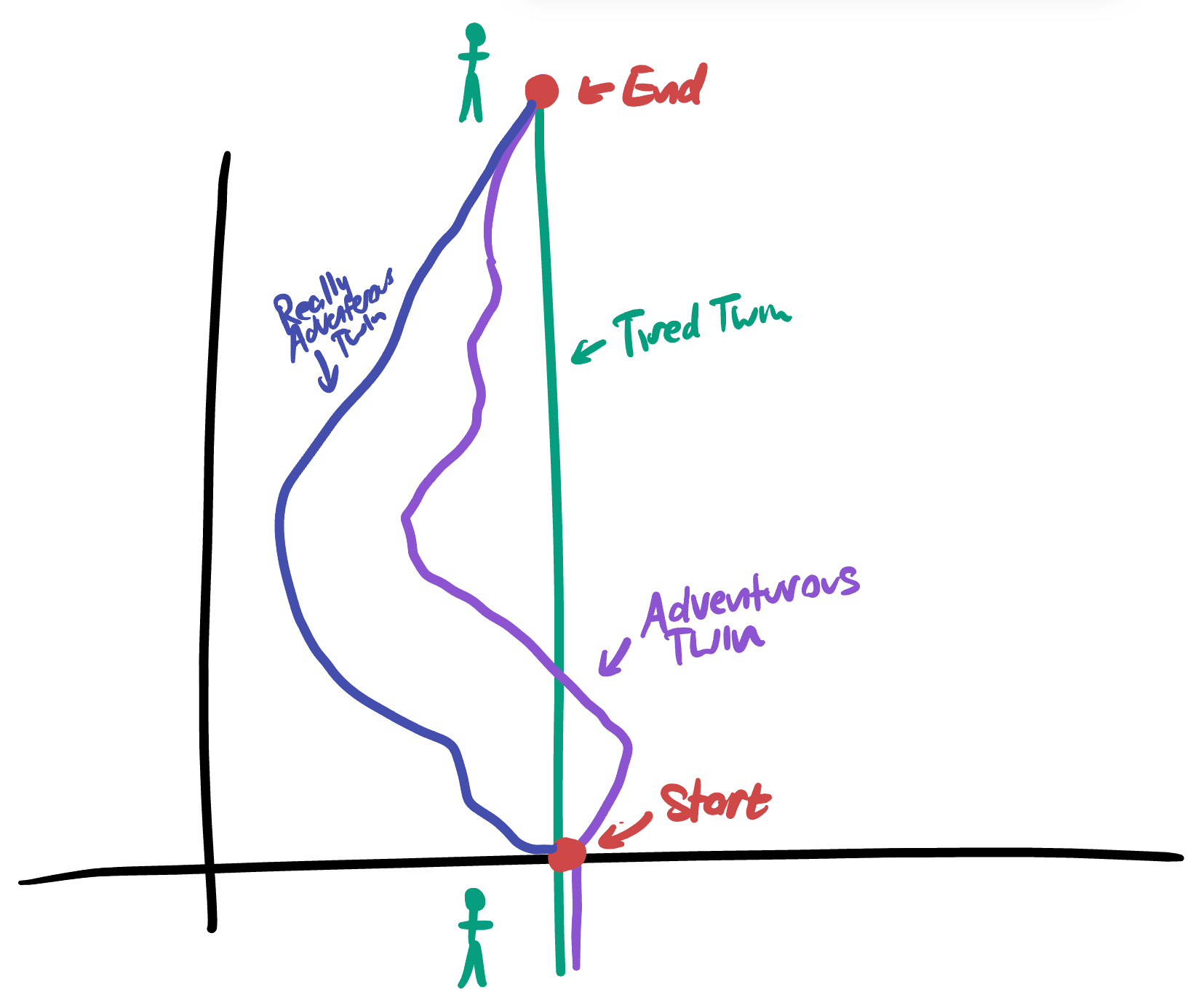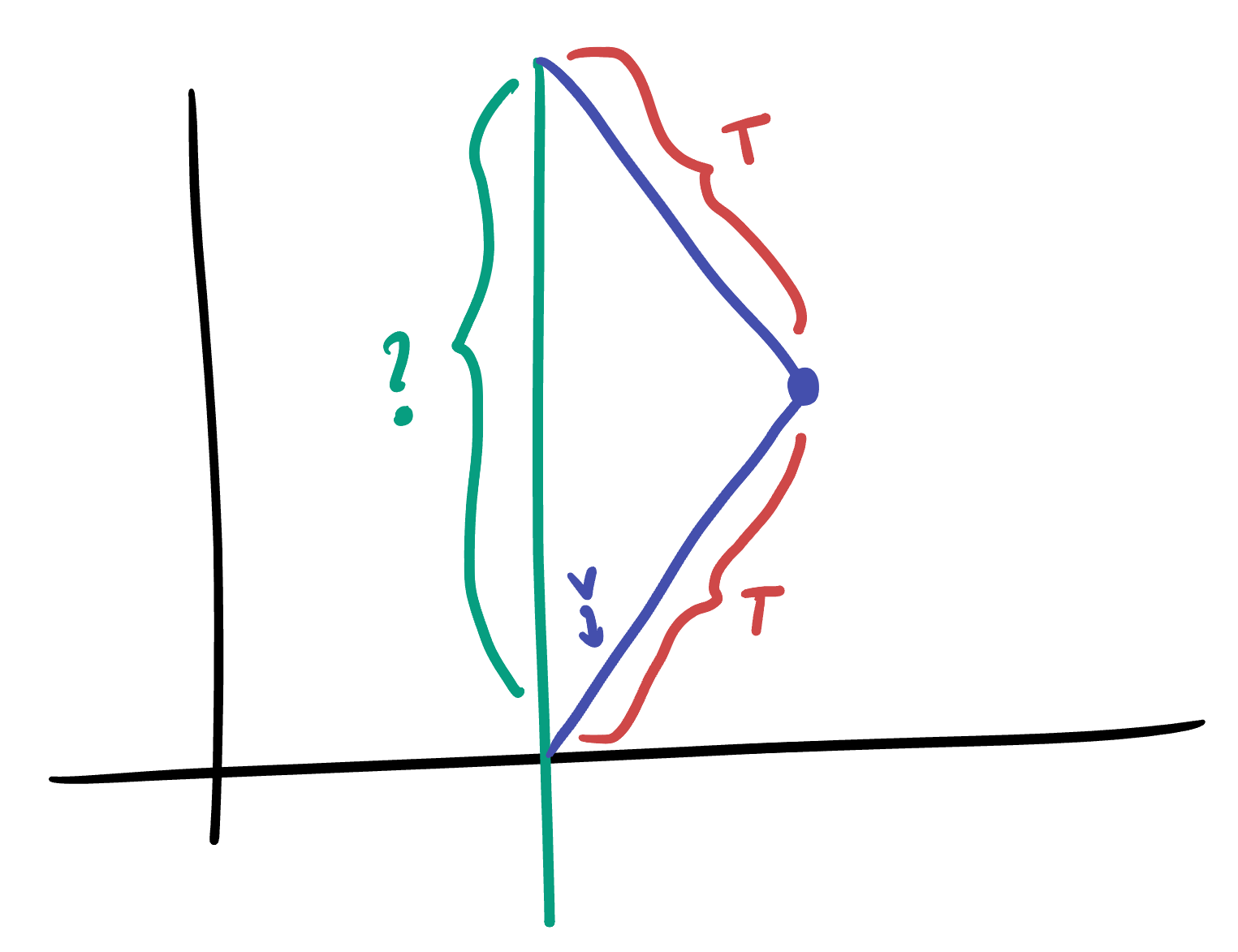32 Relativity
32.1 Symmetries of Spacetime
We’ve shown there are two possible ways the symmetries of spacetime could behave: it can either follow the laws of the Galilean Group
Or, it can follow the symmetries of the Lorentz Group
Where these are applied as linear transformations to the spacetime of events
32.1.1 Observers in Spacetime
Objects in the world are modeled by curves in spacetime
In the coordinates
Exercise 32.1 Show the instantaneous speed is expressible as a derivative
An observer is called constant speed if this
Galileo’s principle says that anyone’s viewpoint on the world is equivalent - that is, that anyone can imagine themselves as not moving. This gives a constraint on the set of curves that describe trajectories we can move on, which we will call observer trajectories. Every observer trajectory must be locally stoppable at each point, in order to obey Galileo’s principle.
In a world with Lorentz symmetry, this already poses a strong constraint: because
While trajectories moving at speed
- An object moving at speed
- You cannot run away from an object moving at speed
Thus not only must such objects never stop moving, but they can never even slow down! They must always travel at speed
32.2 Measuring Time along a Trajectory
If
If the observer is stationary, this is easy: the vertical axis is defined as the time axis of a stationary observer, so we just measure the difference in
So, between
On a general curve
Taking the limit as the interval shrinks to zero and integrating gives the following result for curves of the form
32.2.1 Another Way
We could also carry out this calculation more abstractly (this is the ‘math way’ that we did in the independent study): we know that spacetime with Lorentz symmetries preserves the dot
Which is also preserved (as its just a constant multiple of the original) but now has the same units that
Integrating this over a curve gives
And, for curves of the form
Now we can proceed from this general statement applicable to all curves, to specialize for constant speed trajectories. Say that
This is a remarkably understandable formula! (Even if the consequences are wild) In a diagram, we are measuring the duration experienced along a trajectory simply by the Minkowski Pythagorean Theorem! Take the difference in time coordinates
Side Note: we can rewrite this in terms of the speed
32.3 The Flash vs a Flashlight
Imagine the following setup: you and The Flash are standing still right next to one another, at a distance of

Exercise 32.2
- How much time passed on your clock, by the time the light hits you?
- How much time passes on The Flash’s clock, by the time the light hits him?
- What time will your clock read at the moment that The Flash is hit?
- What time will your clock read when you see The Flash get hit?
32.4 The Twin Paradox
Two twins start out right next to one another. One of decides to stay where they are, and just hang out. The other gets into an fast moving ship and goes on a joyride, following some trajectory

Exercise 32.3 Prove that no matter what trajectory

Exercise 32.4 Say that the adventurous twin leaves home at velocity
32.5 Neither Before nor After
In the Galilean world, everyone agrees which slices of spacetime counts as “space”. These slices define a universal notion of time: given any two events
But, surely the order events occur in is invariant across observers, even if the precise length of time elapsed between them is not - right? Right??
Exercise 32.5 (Wrong) Consider an observer
Hint: If
But not all is lost: there are still pairs of events where everyone agrees the order they occurred in: for instance, it is a fact of the matter that I lived in Minnesota before I lived in California, and not the other way around. Everyone, even fast traveling aliens watching us through super telescopes agrees with this.
:::{#rel-prob-5} Show that if
Hint: Show if
Thus spacetime has events where it is undefined which came first, and others where it is unambiguous which was first. And, there are no events which unambiguously occur at the same time! (This is what physicists call the “Relativity of Simultaneity”). In fact these two types of pairs of events have a nice math interpretation: the ones which can be ordered in time are the pairs of points with negative separation (from our linear algebra chapter) and those which cannot are those with positive separation.
If you feel like getting really confused, this is a good time to go back and think about The Flash and the Flashlight: remember we said that from our friend with the flashlight’s perspective, the following events are simultaneous:
- Him turning on the flashlight
- You and the Flash being right next to one another.
Since you are not moving relative to your friend, you both agree that these events are simultaneous. But The Flash does not! In fact, from the Flash’s perspective, the flashlight is not turned on until much later than he started running: this means from his perspective, there is much more distance for the light to cover before overtaking him (as he had a head start).
Exercise 32.6 Draw in space slices for The Flash into the diagram, and see that the space slice through the point where the flash runs away from you intersects your friend far before he turned on the flashlight. Use geometry and Lorentz transformations to figure out how long after the flash starts running he thinks the flashlight is turned on.
32.6 You Can’t Go Back
The grandfather paradox is a classic time travel story that highlights one of the absurd consequences of entertaining time travel into the past. In it, starting from wherever you are right now, you travel along some path in spacetime and eventually you end up back inside the past light cone of your starting point: somewhere where actions you undertake could affect you where you started!
The classical example is rather violent: you arrive at a time before your parents were born, and kill one of your grandfathers. Thus, no parents, and no you. But how could this be possible, since you exist - after all its you who went back and did this! The one can be much less violent and arrive at similar absurdities: what if along your journey you bring your favorite book to read; and upon your arrival in your past, you meet the author before he has written it. You give him a copy, remarking how much you loved it. If he then reads it, agrees, and submits it for publication, who wrote the book?
In fact, this book example provides a much better picture of what must be going on mathematically than the grandfather case. Indeed, track the book: starting in your hand, it follows you (on an observer’s trajectory) until it meets the author, at which point it changes hands and follows the author (also an observer’s trajectory) until it ends up on a bookstore’s shelf, and then gets into your hands! At each point in time the book was following an observer’s trajectory (either literally with you or the author, or sitting motionless on a shelf), but at the end of its journey it ended up at the same spacetime event where it began.
That means the trajectory of our book is a closed curve: a loop in spacetime!

Exercise 32.7 Show that there are no closed observer trajectories in spacetime with Lorentzian symmetries. Thus, you can never visit the past!
Hint: An observer trajectory must always have its tangent vector lying inside the negative cone. But if